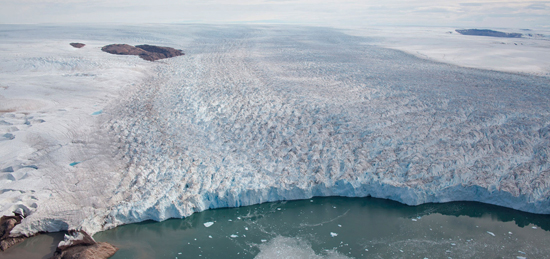UAlbany Study: Arctic Sea Ice Melt Fueling Greenland Ice Sheet Loss, Rising Sea Levels
 |
|
A new study finds a link between Arctic sea ice loss and the rapid melting of the Greenland Ice Sheet. (Photo: Niels J. Korsgaard, Natural History Museum
of Denmark used by permission)
|
ALBANY, N.Y. (April 4, 2016) -- "Blocking High" weather systems -- modulated by reduced summer sea ice in the Arctic -- are contributing to more extreme heat events over Greenland, according to a new study led by University at Albany Assistant Professor of Atmospheric and Environmental Sciences Jiping Liu. This is fueling extensive Greenland ice sheet surface melting, which in turn is contributing to rising global sea levels.
Recently published online in the Journal of Climate, the study shows for the first time how the Arctic sea ice melt is an underlying cause to the Greenland ice sheet shrinking that has been observed in recent decades.
The study notes that reduced summer sea ice is contributing to stronger and more frequent occurrences of blocking-high pressure events. The systems, which spin clockwise, stay largely in central and south Greenland and can enhance the transport of warm and moist air over Greenland, which in turn increases the rapid ice sheet melting.
 |
|
Assistant Professor of Atmospheric and Environmental Sciences Jiping Liu
|
"The systems also cause increases downward infrared radiation that adds more energy to the surface of the ice sheet, and accounts for the majority of the observed warming trends," said Liu. "These findings are supported by analyses of observations and reanalysis data, as well as by independent atmospheric simulations using a state-of-the-art atmospheric model that is forced by varying only the sea ice conditions."
Since 2009, most of the increased rate of Greenland ice loss has stemmed from greater surface melting, heightening concerns that sea level-rise could accelerate beyond most projections as Arctic sea ice continues to decline and boost threat levels for coastal communities through storm surge, erosion and shoreline change etc., the study says.
The report comes on the heels of similar studies indicating that the Antarctic ice sheet may melt much faster than previously predicted by NASA’s National Snow & Ice Data Center, as well as researchers at the University of Massachusetts and Pennsylvania State University.
According to NSIDC, the Antarctic and Greenland ice sheets contain more than 99 percent of the freshwater ice on Earth. The Greenland Ice Sheet extends about 0.66 million square miles -- three times the size of Texas. The global sea level would rise to about 20 feet if it completely melted, causing widespread devastation to the planet’s coastal cities and towns.
The Antarctic Ice Sheet extends almost 5.4 million square miles -- roughly the area of the contiguous United States and Mexico combined. If the Antarctic Ice Sheet melted, the global sea level would rise about 200 feet.
Along with Liu, the study’s authors include Jennifer Francis of Rutgers University; Zhiqiang Chen and Mirong Song of the Chinese Academy of Sciences in Beijing, China; Thomas Mote of the University of Georgia; and Yongyun Hu of Peking University in Beijing.
![]() For more news, subscribe to UAlbany's RSS headline feeds
For more news, subscribe to UAlbany's RSS headline feeds
A comprehensive public research university, the University at Albany-SUNY offers more than 120 undergraduate majors and minors and 125 master's, doctoral and graduate certificate programs. UAlbany is a leader among all New York State colleges and universities in such diverse fields as atmospheric and environmental sciences, business, education, public health,health sciences, criminal justice, emergency preparedness, engineering and applied sciences, informatics, public administration, social welfare and sociology, taught by an extensive roster of faculty experts. It also offers expanded academic and research opportunities for students through an affiliation with Albany Law School. With a curriculum enhanced by 600 study-abroad opportunities, UAlbany launches great careers.


